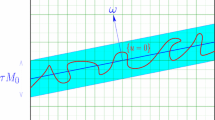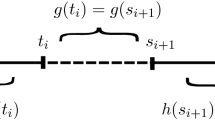Abstract
We consider mass-constrained minimizers for a class of non-convex energy functionals involving a double-well potential. Based upon global quadratic lower bounds to the energy, we introduce a simple strategy to find sufficient conditions on a given critical point (metastable state) to be a global minimizer. We show that this strategy works well for the one exact and known metastable state: the constant state. In doing so, we numerically derive an almost optimal lower bound for both the order–disorder transition curve of the Ohta–Kawasaki energy and the liquid–solid interface of the phase-field crystal energy. We discuss how this strategy extends to non-constant computed metastable states, and the resulting symmetry issues that one must overcome. We give a preliminary analysis of these symmetry issues by addressing the global optimality of a computed lamellar structure for the Ohta–Kawasaki energy in one (1D) and two (2D) space dimensions. We also consider global optimality of a non-constant state for a spatially in-homogenous perturbation of the 2D Ohta–Kawasaki energy. Finally we use one of our simple quadratic lower bounds to rigorously prove that for certain values of the Ohta–Kawasaki parameter and aspect ratio of an asymmetric torus, any global minimizer \(v(x)\) for the 1D problem is automatically a global minimizer for the 2D problem on the asymmetric torus.

















Similar content being viewed by others
Notes
Given the simplicity of the idea of a global convex bound, it seems likely that it has been invoked in the past. We note that the idea has been recently used in Fratta et al. (2014) to study profiles of point defects in the Landau–de Gennes theory of liquid crystals.
For example, in (OK) the term \(a(f, m) = 0\) trivially, while in (PFC) the term \(a(f, m) = 0\) follows from \(\langle f \rangle = 0\).
For (OK)
$$\begin{aligned} B = \gamma ^{-2} (-\varDelta ) + (-\varDelta )^{-1} + (3 m^{2} - 1), \end{aligned}$$while for (PFC),
$$\begin{aligned} B = (1 + \varDelta )^{2} + (3 m^{2} - \epsilon ). \end{aligned}$$Observe that for two values \(\gamma _{1} < \gamma _{2}\), the difference in the associated operators \(B_{2} - B_{1}\) is positive-definite. Indeed, \( B_{1} - B_{2} = -\big (\gamma _{1}^{-2} - \gamma _{2}^{-2}\big )\varDelta \), and multiplying each side first on the left by \(B_{1}^{-1}\) and then on the right by \(B_{2}^{-1}\), we have
$$\begin{aligned} B_{2}^{-1} - B_{1}^{-1} = \big (\gamma _{1}^{-2} - \gamma _{2}^{-2}\big ) B_{1}^{-1} \; \big ( -\varDelta \big ) \; B_{2}^{-1} \end{aligned}$$But \(B = B_{1}^{-1} \; ( -\varDelta ) \; B_{2}^{-1}\) is the product of three self-adjoint, positive-definite operators, and on the torus, \(B_{1}\), \((-\varDelta )\), \(B_{2}\) all mutually commute. As a result \(B\) is self-adjoint and positive-definite, and one can use the complete set of common eigenfunctions to show that every eigenvalue of \(B\) is positive. It follows that for any function \(g(\mathbf {x}) \ne 0\), we have \(\langle g, B_{2}^{-1} g \rangle > \langle g, B_{1}^{-1} g \rangle \). This proves that the associated ratios \(r_{2}\) and \(r_{1}\) corresponding to \(\gamma _{2}\) and \(\gamma _{1}\) satisfy \(r_{2} > r_{1}\). An identical argument holds for \(\epsilon \) in (PFC).
As a numerical note, we compute \(B^{-1}\) as follows. We build the following operator
$$\begin{aligned} Lf&= \gamma ^{-2}(\varDelta ^{2})f - \varDelta \big [ (3 v^{2}(\mathbf {x}) - 1)f\big ] + f \end{aligned}$$and note that \( B = (-\varDelta )^{-1} L.\) Hence the inverse can be computed as
$$\begin{aligned} g^{n+1}&= \beta ^{n} \big ( (v L^{-1} (-\varDelta ) v) g^{n} \big )_{+} \end{aligned}$$For simplicity, when defining \(e_{1}\) and \(e_{2}\) we take the derivatives in the \((1,0)\), or \(x\) direction. Due to the fact that \(v^l\) is a lamellae, the derivative along \((1,0)\) is proportional to the derivative along the direction \((1,1)\).
Here \(1/4\) is the Poincaré constant for the torus with length \(4\pi \).
We refer to an energy landscape of a functional \({\mathcal {F}}\) in the vicinity of a local minimize \(v\) as flat, if the associated \(b(f,f)\) has an eigenvalue \(\epsilon \ll 1\) with eigenvector \(f_{\epsilon }\) (with \(||f_{\epsilon }|| = 1\)). These directions \(f_{\epsilon }\) need not be related to symmetries of \(v\). We observe that as one either increases the domain \(\varOmega \) or increases \(\gamma \) in (OK), (1) the number of small eigenvalues \(\epsilon \) of \(b(f,f)\) increase, and (2) the amplitude of the small eigenvalues also decreases. Hence, in this respect we say (OK) becomes increasingly flat.
Although the second eigenvalue \(0.0149\) is close to \(0\), the values are accurate to approximately \(10^{-4}\).
References
Adams, S., Dirr, N., Peletier, M., Zimmer, J.: From a large-deviations principle to the Wasserstein gradient flow: a New micro–macro passage. Commun. Math. Phys. 307, 791–815 (2011)
Beck, M., Knobloch, J., Lloyd, D., Sandstede, B., Wagenknecht, T.: Snakes, ladders, and isolas of localized patterns. SIAM J. Math. Anal. 41, 936–972 (2009)
Cahn, J., Hilliard, J.: Free energy of a nonuniform system I. Interfacial free energy. J. Chem. Phys. 28, 258–267 (1958)
Choksi, R.: On global minimizers for a variational problem with long-range interactions. Q. Appl. Math. 70–3, 517–537 (2012)
Choksi, R., Maras, M., Williams, J.: 2D phase diagram for minimizers of a Cahn–Hilliard functional with long-range interactions. SIAM J. Appl. Dyn. Syst. 10, 344–1362 (2011)
Choksi, R., Peletier, M.A., Williams, J.: On the phase diagram for microphase separation of diblock copolymers: an approach via a nonlocal Cahn–Hilliard functional. SIAM J. Appl. Math. 69–6, 1712–1738 (2009)
Cicalese, M., Spadaro, E., Zeppieri, C.: Asymptotic analysis of a second-order singular perturbation model for phase transitions. Calc. Var. Partial Differ. Equ. 41, 127–150 (2011)
Coleman, B., Marcus, M., Mizel, V.: On the thermodynamics of periodic phases. Arch. Rational Mech. Anal. 117, 321–347 (1992)
Cross, M., Hohenberg, P.: Pattern formation outside of equilibrium. Rev. Mod. Phys. 65, 851–1111 (1993)
Desai, R., Kapral, R.: Dynamics of Self-Organized and Self-Assembled Structures. Cambridge University Press, Cambridge (2009)
Di Fratta, G., Robbins, J., Slastikov, V., Zarnescu, A.: Profiles of point defects in two dimensions in Landau–de Gennes theory. Preprint (2014)
Elder, K.R., Katakowski, M., Haataja, M., Grant, M.: Modeling elasticity in crystal growth. Phys. Rev. Lett. 88, 245701 (2002)
Emmerich, H., Löwen, H., Wittkowski, R., Gruhn, T., Tóth, G., Tegzec, G., Grnsy, L.: Phase-field-crystal models for condensed matter dynamics on atomic length and diffusive time scales: an overview. Adv. Phys. 61, 665–743 (2012)
Glasner, K.: Spatially localized structures in diblock copolymer mixtures. SIAM J. Appl. Math. 70, 2045–2074 (2010)
Jordan, R., Kinderlehrer, D., Otto, F.: The variational formulation of the Fokker–Planck equation. SIAM J. Math. Anal. 29, 1–17 (1998)
Kohn, R.: Energy-driven pattern formation. In: Proceedings of the International Congress of Mathematicians, vol. I, pp. 359–383 (2007)
Morini, M., Sternberg, P.: Cascade of minimizers for a nonlocal isoperimetric problem on thin domains. SIAM Math. Anal. 46(3), 2033–2051 (2013)
Müller, S.: Singular perturbations as a selection criterion for periodic minimizing sequences. Calc. Var. Partial Differ. Equ. 1, 169–204 (1993)
Netz, R., Andelman, D., Schick, M.: Interfaces of modulated phases. Phys. Rev. Lett. 79, 1058 (1997)
Ohta, T., Kawasaki, K.: Equilibrium morphology of block copolymer melts. Macromolecules 19, 2621–2632 (1986)
Ren, X., Wei, J.: On energy minimizers of the diblock copolymer problem. Interfaces Free Bound. 5, 193–238 (2003)
Seul, M., Andelman, D.: Domain shapes and patterns: the phenomenology of modulated phases. Science 267, 467 (1995)
Swift, J., Hohenberg, P.: Hydrodynamic fluctuations at the convective instability. Phys. Rev. A 15, 319–328 (1977)
Villain-Guillot, S., Andelman, D.: The Lamellar-disorder interface: one-dimensional modulated profiles. Eur. Phys. J. B, 95–101 (1998)
Yip, N.: Structure of stable solutions of a one-dimensional variational problem. ESAIM: Control Optim. Cal. Var. 12–4, 721–751 (2006)
Acknowledgments
We are indebted to one of the referees for their detailed comments that substantially improved the article. The authors would like to thank Ben Mares, Cyrill Muratov, Leo Stein, Marco Veneroni, and Thomas Wanner for useful conservations, comments, and suggestions. This research was partly supported by NSERC (Canada) Discovery Grants. J.-C.N. was also supported by an NSERC Accelerator Supplement.
Author information
Authors and Affiliations
Corresponding author
Additional information
Communicated by Robert V. Kohn.
Appendix: Solving the Constrained Eigenvalue Problem
Appendix: Solving the Constrained Eigenvalue Problem
We seek to compute the minimizer of \(\langle \psi , (B - 2v^{2})\psi \rangle \) subject to
Due to the large matrices involved, it is more efficient to first ignore the orthogonality constraint and build a low rank approximation to \((B-2v^{2})\) over the entire unconstrained space. Once the low rank approximation is built, we then project out the appropriate orthogonality constraints and solve for the minimizer of \((B- 2v^{2})\).
-
1.
Build numerical finite difference operators:
$$\begin{aligned} \mathbf {L}&= \gamma ^{-2}(\varDelta ^{2}) - (\varDelta )(3v^{2}(\mathbf {x}) - 1) + I, \\ \mathbf {D}&= (-\varDelta ). \end{aligned}$$ -
2.
Use MATLAB’s eigenvalue function
$$\begin{aligned}{}[\mathbf {Q} \;\; \varvec{\Lambda } ] = eigs( \mathbf {L}, \; \mathbf {D}, \; k, \;\hbox {`}sm\hbox {'}) \end{aligned}$$to compute the first k eigenvectors and values to the eigenvalue problem:
$$\begin{aligned} \mathbf {L} \mathbf {q}_{j}&= \lambda _{j} \mathbf {D} \mathbf {q}_{j} \quad j = 1,\ldots , k. \end{aligned}$$Here \(\mathbf {Q} = [\mathbf {q}_{1} \; \mathbf {q}_{2}, \ldots , \mathbf {q}_{k}]\), while \({\varvec{\Lambda }} = {\hbox {diag}}[\lambda _{1} \; \lambda _{2},\ldots ,\lambda _k]\).
-
3.
Orthonormalize \(\mathbf {q}\) with respect to the standard \(\ell ^{2}\) inner product (if they are not orthonormal already).
We now have the numerical representation for operator \((B-2v^{2})\) as follows:
where \(\mathbf {R}^{T} = \mathbf {R}\) is a remainder term. Choose \(k\) large enough so that \(\mathbf {R}\) is a positive-definite matrix. Hence for any discrete vector \(\psi \), we then have:
Finally, we minimize \(\psi ^{T} \mathbf {Q} {\varvec{\Lambda }} \mathbf {Q}^{T} \psi \) over the subspace \(\psi ^{T} \mathbf {e}_{1} = 0\) with \(||\psi || = 1\), where \(\mathbf {e}_{1} \approx \frac{\partial v}{\partial x}\) is the discrete vector for \(\frac{\partial v}{\partial x}\). The above problem can be solved using straightforward methods as \(k\) will generally be small.
Rights and permissions
About this article
Cite this article
Shirokoff, D., Choksi, R. & Nave, JC. Sufficient Conditions for Global Minimality of Metastable States in a Class of Non-convex Functionals: A Simple Approach Via Quadratic Lower Bounds. J Nonlinear Sci 25, 539–582 (2015). https://doi.org/10.1007/s00332-015-9234-0
Received:
Accepted:
Published:
Issue Date:
DOI: https://doi.org/10.1007/s00332-015-9234-0
Keywords
- Global minimizers
- Non-convex energy
- Double-well potential
- Metastable state
- Convex/quadratic lower bound
- Ohta–Kawasaki functional
- Phase-field crystal functional




